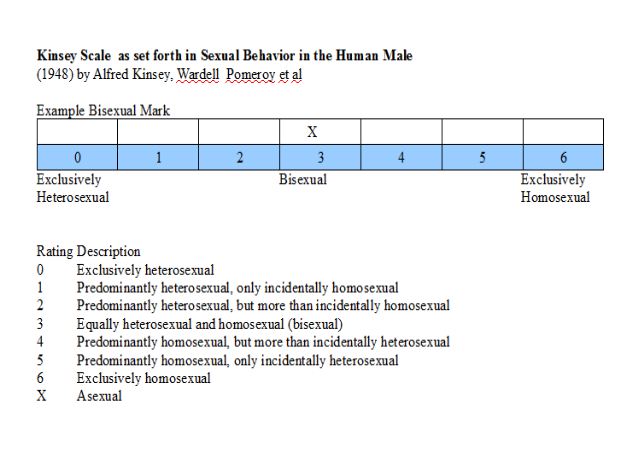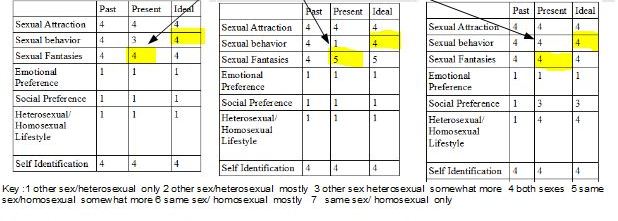We are told we live in a binary world where we are expected to be either attracted to males or females but the fact is as any bisexual will tell you we do not live in a binary world.
Dr Kinsey created the Kinsey scale which allowed people to plot the degree of sexual attraction to opposite sex or same sex. Using the Kinsey scale is as easy as can be just put a mark on the scale that most accurately reflects the degree of hetrosexual/homosexual sexual attraction The disadvantage to the Kinsey scale is it is too one dimensional .

Adapted from the Kinesey scale Kinsey, Alfred et al -Sexual behavior in the human male Indiana University Press 1948 (described on page 639)
The Klein Grid an improvement.
The Klein Sexual Orientation Grid developed by Fritz Klein takes into account past present and ideal elements of our sexual orientation .The Klein grid is especially useful to help identify variations between your present situation and your ideal situation. It also incorporates the various components of bisexuality. For example it is not uncommon for a bisexual to have emotional preferences to women with a sexual preference to men. The Klein grid can be very helpful in making sure how one leads their life is aligned with how they want to lead their life. In other words if the Klein grid shows one is sexually attracted to both men and women and they fantasize about both men and woman and in an Ideal world sexual satisfaction would come from both sexes then it seems clear to me that a relationship with only one gender might cause a disconnect between actual living and who they want to be. In any case a review of the Klein grid is certainly helpful in self awareness. In a sense the bisexual who pretends to be a heterosexual is play acting their way through life. Richard R. Troiden (1988) said “Homosexual identities are most fully realized when self-identity, perceived identity, and presented identity coincide; that is, where an accord exists among who people think they are, who they claim they are, and how others view them” .
It's a Grid not a score
It is important to know that Frizt Klein the createor of the Klein Grid inisted that the model be used as a grid and not a single score. Due to widespread dumbing down of this model on the internet and the increasing number of sites creating averaging and single summary scores the true value of the Klein Grid is being lost. I wish the the creaters of the sites that use averages and sumamry scores would read chapter 2 of Fritz Kleins book The Bisexual Option where he makes very clear his model is supposed to be used as a grid. Fritz Klein writes "The concept of an oingoing, dynamic process must be included if we are to understand a persons oriuentation" He goes on to write "Rather than use only one number to describe someone's sexual orientation, it becomes necessary to use a grid. The KleinSexual Orientation Grid was therefore developed to take these factors into account. This grid lets us see and understand at one glance what a particular person's orientation is." Klein 1993
The sample below is of a sample subject at 18, 30, and 55. Notice the disparity between present and ideal in the middle one.
18 30 55
The Klein Grid was developed by Dr. Fritz Klein and this example of the use of the Klein Grid was adapted from information obtained from his book The Bisexual Option By Fritz Klein, MD Copyright 1993 by the Haworth Press. The Klein grid is used here for the limited purpose of academic discussion of a specific case study .For all other use please refer to Klein’s original published work. As the Klein grid might raise some issues not previously examined I suggest it be used in conjunction with counseling with a trained certified mental health professional.
A disadvantage to both these scales is they are either or oriented. By that I mean as one becomes more attracted to one they become less attracted to another. In addition they imply that at the mid point one is equally attracted to both. This simply does not reflect the reality of most bisexuals. Researchers have struggled to classify exactly what a bisexual is. In fact there are many variations and I believe the bisexual label serves as a great conversation starter but to really understand a bisexual you need to pull up a chair and have a meaningful conversation. One researcher R. Little is reported to have identified 13 types of bisexual (citation needed) . when I reviewed his list for myself I didnt fit any of the 13 definitions and yet I am 100% bisexual.
Storms Model
Michael Storms, a psychologist at the University of Kansas (Storms 1980 ) proposed yet another model that shows who we are sexually attracted to are independent of each other . This is sometimes known as the x/y model to reflect two independent axis. In other words how attracted we are to one sex says nothing about how attracted we are to the other. He found that bisexuals could be just as heterosexual as heterosexuals while at the same time being just as homosexual as the purely homosexual subjects. My experience is this is true. This scale also allows us to properly account for the day to day ebb and flow of our sexual attraction. This variation in how sexually attracted we are to each gender appears to be a common attribute of the typical bisexuals day to day life. On a typical day a bisexual might be very attracted to both men and women and would be happy with either one,. On others they may have a distinct preference for one or the other. In the early stages of accepting bisexuality it is common for this ebb and flow to cause angst. Bisexuals who are in this question phase ask themselves ,I think I might be gay, but Im also attracted to the opposite sex, how can one be attracted to both. Eventually we come to realize that in fact that is exactly who we are bisexuals with attraction to both men and women.
References
Kinsey, Alfred et al -Sexual behavior in the human male Indiana University Press 1948
Klein, Fritz – The Bisexual Option Copyright 1993 by the Haworth Press.
Troiden, Richard, R Gay and lesbian identity: a sociological analysis
1988
Storms, M. (1980). Theories of Sexual Orientation. Journal of Personality and Social Psychology, 783-792.

